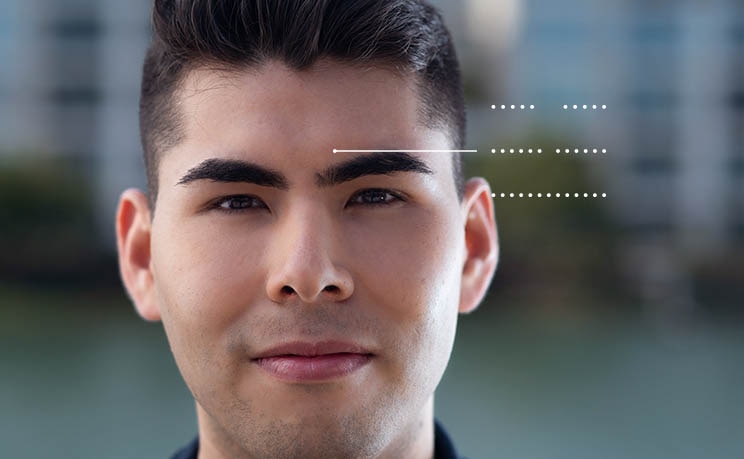AncestryDNA® Traits
Unibrow
Most people have two distinct eyebrows, with a more faint type of hair between their brows. But for some people, this hair is thicker, more like eyebrow hair. And this creates the appearance of one long eyebrow—a unibrow.
Although the knowledge science currently has about the inheritance of unibrows is limited, the AncestryDNA® + Traits test can tell you if your DNA indicates that you may have a unibrow.

More About Unibrows
Throughout history, eyebrow styles have changed, with fashion dictating how people have shaped and groomed them. This varied from penciling in a unibrow to plucking or tweezing the eyebrows completely—a total brow hair removal.
In ancient Greece, having one eyebrow was considered beautiful. Desirable and intelligent women had them. Rich Greek women would paint on unibrows if they didn't have them naturally.
In the Middle Ages, women wanted to have a large forehead, so they shaved or plucked their eyebrows to achieve that effect.
Today some cultures value the one-eyebrow look. In Tajikistan, for example, women use a leafy herb called usma to paint a monobrow.
The Genetics of Unibrows
Whether or not you have a unibrow is only partly due to your genes. Other things like grooming can influence how your eyebrows look and how your brow hair grows back. Different forms of hair removal, like tweezing, waxing, or electrolysis, for example, can permanently change your eyebrow shape.
AncestryDNA scientists have identified over 8,500 DNA markers associated with whether a person is likely to have a unibrow or not. Some of these markers are near a gene called PAX3, located on chromosome 2, which other researchers had previously found could influence whether or not your eyebrows meet in the middle. Differences in the DNA at the gene seem to correspond with varying degrees of unibrow.
For the many other DNA markers associated with eyebrow shape and thickness, scientists are still looking at how they might influence that trait.
The Science Behind Unibrows
Can your biological mom or dad take credit for how close your brows come together? They can indeed—at least partly. Each of your parents passes down to you a copy of the genes that influence unibrows—like the PAX3 gene. Which version of the genes you get from each parent can help determine whether or not your eyebrows meet in the middle.
And just because you have thick hair on your head or a dense beard doesn't mean you'll have bushy eyebrows or a unibrow. The genes for eyebrow thickness, beard thickness, and hair type are different. So you can have thin hair on your scalp and thick eyebrows that grow together in the middle. Or you can have thick hair, a heavy beard, and sparse eyebrows.
Interesting Findings About Unibrows
Unibrows may seem more common in men, but they happen in both sexes. In much of the Western world, women are just more likely to remove the extra hair.
There are a few well-known examples of celebrities with unibrows, like the American professional basketball player, Anthony Davis. But perhaps the most famous unibrow in history belongs to Mexican artist Frida Kahlo, whose unibrow featured prominently in her iconic self-portraits.
Eyebrows serve an important biological role, keeping sweat and rain out of your eyes. They also have symbolic roles. Some cultures think the unibrow is good luck. And some consider it a sign of fertility.
References
Adhikari K, Fontanil T, Cal S, et al. "A genome-wide association scan in admixed Latin Americans identifies loci influencing facial and scalp hair features." Nature Communications. March 1, 2016. https://doi.org/10.1038/ncomms10815.
Adhikari, Kaustubh. "How we discovered the genetic origin of the 'monobrow' and other hair traits." The Conversation. March 1, 2016. https://theconversation.com/how-we-discovered-the-genetic-origin-of-the-monobrow-and-other-hair-traits-55548.
Chertoff, Jane. "This Is Why Your Eyebrows Are Thinner Than They Used to Be—and What to Do About It." Self. July 13, 2018. https://www.self.com/story/thinning-eyebrows.
Ghose, Tia. "Genetics of the Unibrow Revealed." Live Science. March 1, 2016. https://www.livescience.com/53896-genetics-of-unibrows-revealed.html.
Kumar P. "Synophrys: Epidemiological study." International Journal of Trichology. 2017. https://pubmed.ncbi.nlm.nih.gov/28932060/.
Lord, Annie. "A cultural history of the eyebrow." i-D Vice Media Group. February 18, 2018. https://i-d.vice.com/en_uk/article/mb4pjv/a-cultural-history-of-the-eyebrow.
Pickrell JK, Berisa T, Liu JZ, et al. "Detection and interpretation of shared genetic influences on 42 human traits." Nature Genetics. May 16, 2016. https://www.nature.com/articles/ng.3570.
Sharping, Nathaniel. "When eyebrows collide: scientists map the genetics of facial hair." Discover Magazine. March 1, 2016. https://www.discovermagazine.com/health/when-eyebrows-collide-scientists-map-the-genetics-of-facial-hair.